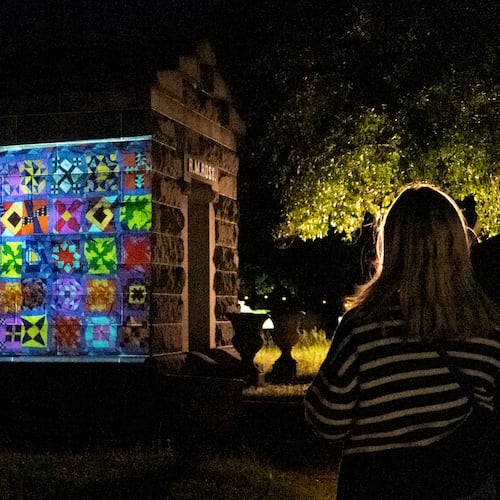The father of American landscape architecture, Frederick Law Olmsted shaped America in the 19th century, with designs including New York’s Central Park, Asheville’s The Biltmore House and the U.S. Capitol grounds. His reach extended to Atlanta’s Druid Hills neighborhood and the Olmsted Linear Park along Ponce de Leon Avenue before his death in 1903.
Half a century earlier, however, Olmsted had different ambitions for influencing the American landscape. A 30-year-old dilettante farmer and traveling journalist, he took a commission from the New York Daily News (now the New York Times) to tour the Southern slave states and Texas in the early 1850s. Originally published under the pen name “Yeoman,” Olmsted’s accounts were collected in multiple books that captured the distinct geography and politics of the South at the eve of the Civil War.
Pulitzer Prize-winning journalist Tony Horwitz, author of the acclaimed “Confederates in the Attic,” quotes Olmsted early in his new book “Spying on the South.” “Before embarking on his Southern tour, Olmsted wrote a friend that he sought ‘reliable understanding of the sentiments and hopes & fears’ of Americans on the other side of the nation’s widening divide.” Traveling the South ahead of the 2016 presidential election, Horwitz takes inspiration from Olmsted’s route and his perspective on cultural tensions, finding contemporary parallels in the 21st century’s “extreme polarization, racial strife” and more.
Subtitled “An Odyssey Across the American Divide,” “Spying on the South” retraces Olmsted’s 6,000-mile travels into Appalachia, along the Ohio and Mississippi rivers, through Dixie’s major cities and forgotten villages until crossing the Rio Grande into Mexico, ending with an epilogue in Central Park. (Olmsted’s 1850s swing did not pass through Georgia, so neither does Horwitz.)
“Spying on the South’s” overall thesis comes across as a little fuzzy, alternating between modern-day travelogue, biographical sketches of Olmsted and sociopolitical commentary on class and race in the South. But even when the book’s general direction seems vague, Horwitz’s excellence as a writer and reporter unearths forgotten chapters of history while making fascinating present-day discoveries.
Horwitz describes his goal of following in Olmsted’s footsteps as much as possible, given that many of the roads and settlements have long vanished. He frequently improvises his itinerary, at one pointing hitching a ride for several days on a massive coal barge on the Ohio River. This glimpse into the dangers and tedium of 21st century blue collar work sharply contrasts with a jaunt on a Mississippi riverboat, converted into a pleasure cruise for retirees. When Horwitz visits such familiar tourist destinations as New York or The Alamo, he clearly tries to avoid travel-writing clichés as he cheerfully chats with strangers in small-town bars or docents at obscure museums.
Horwitz’s enthusiasm can be infectious. Like Olmsted himself, he becomes fascinated with a settlement of utopian Germans in south central Texas. Olmsted grew more radicalized against slavery the more he saw plantation brutality, and Horwitz points out the ironies of changing dynamics at the Mexican border: In the 1850s, runaway slaves would flee into Mexico seeking opportunities, while today’s illegal immigrants go in the other direction.
The author’s optimism at reaching across political divides takes a blow in Crockett, Texas, where he meets a group of paranoid conservatives convinced that there’s a Muslim training compound near town. Horwitz does a little digging and finds that the structure is just a Pakistani doctor’s residence with a security fence surrounding a large property. But when the author brings the truth to his new acquaintances, he’s disappointed when they brush aside the facts and remain unshaken in their beliefs.
“Spying on the South” makes some sharp changes in tone, at times putting aside the grim aspects of the past and present for some breezy interludes, including a visit to Louisiana’s “Mudfest,” a festival of mud, alcohol and monster trucks. At times Horwitz seems eager to emulate the wry observations of Bill Bryson and other lighthearted travel writers. When he briefly links up with Australian humorist Andrew Denton, though, his new travelling companion mostly complains about unhealthy Southern food and comes across as a condescending snob.
Since Olmsted spent much of his travel on horseback, Horwitz’s attempts to experience life in the saddle lead him to a trail guide recommended as a “mule man extraordinaire.” After several days together, Horwitz finds that the Texan, who at first seemed to be a tough, modern-day cowboy, is a just verbally abusive jerk, contemptuous of the author for reasons never explained. Horwitz’s writing makes the episode compellingly enraging, but it also feels sour and unresolved.
Overall, “Spying on the South’s” strongest moments find Horwitz connecting with Southerners and relaying his first-hand observations. The author seems uncomfortable with generalizing over contemporary “Red State” politics in the transition from the Obama to Trump presidencies, as if he’s aware that doing justice to the topic would send the narrative far afield from its mission as more of a historical travelogue.
At times “Spying on the South’s” extensive references to the legs of Olmsted’s journey tend to blur together. But the 19th century landscape architect, like the contemporary journalist, come across as kindred spirits, full of curiosity and open-mindedness about the South, candid about its flaws yet eager to celebrate its positive sides. They both make great traveling companions.
NONFICTION
‘Spying on the South’
by Tony Horwitz
Penguin Press
476 pages, $30
About the Author
Keep Reading
The Latest
Featured


